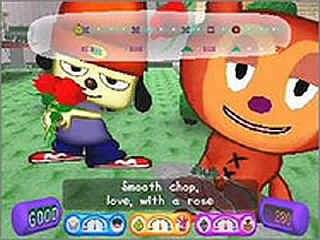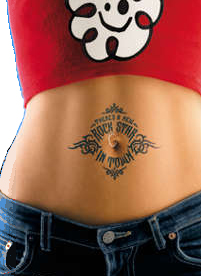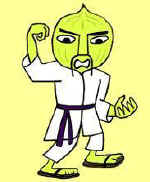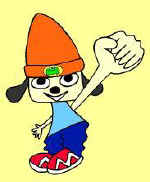PaRappin’ With Rodney Greenblat There was a place, and there was a time, when music-based videogames were few and far between (as James Brown might have sung but didn’t). This month, I’ve chosen to highlight one of the early, influential series of the musical game genre. This trilogy consists of Parappa the Rapper, Um Jammer Lammy, and Parappa the Rapper 2. The first two were released for the PlayStation in 1997 and 1999 respectively, and the third was released for the PlayStation 2 in 2001. The man behind the games was Masaya Matsuura, Japanese musician and videogame designer extraordinaire. He worked on the games with Rodney Greenblat, world-class artist and a pretty good musician in his own right, who designed the characters for the Parappa series. Looking for some behind the scenes info on the creative process that spawned Parappa, I interviewed Mr. Greenblat in the summer of 2002 about Parappa the Rapper 2, where he gave up some insight on his involvement with the entire series. The original article and review of the game was published on the hip-hop website luv4art in an abridged form. But now, here for the first time ever is the unabridged 1000+ word interview in its entirety, courtesy of Digital Press.  In this interview, I asked Parappa the Rapper 2’s character designer, Rodney A. Greenblat, what he thought the direction Parappa was headed in, among other things. Mr. Greenblat is an accomplished artist and designer who lives in New York City and has a variety of projects to his name, including several children’s storybooks and two interactive CD-ROMs for children. A large part of the success of Parappa the Rapper can be attributed to Mr. Greenblat, as he is literally a household name in Japan (his characters adorn the boxes of a popular breakfast cereal). In this interview, I asked Parappa the Rapper 2’s character designer, Rodney A. Greenblat, what he thought the direction Parappa was headed in, among other things. Mr. Greenblat is an accomplished artist and designer who lives in New York City and has a variety of projects to his name, including several children’s storybooks and two interactive CD-ROMs for children. A large part of the success of Parappa the Rapper can be attributed to Mr. Greenblat, as he is literally a household name in Japan (his characters adorn the boxes of a popular breakfast cereal).
Jessen Jurado: After the success of the original Parappa, I'm sure there was a lot more pressure on yourself and Mr. Matsuura to top it with the sequel. What designs did you come to Parappa 2 knowing you immediately wanted to incorporate, and what ideas came to you as the project went on? Rodney Greenblat: There was a lot of pressure to make an even better game. Too much. Matsuura felt he must do something radical and shocking. I didn't agree. I wanted to do something simple. Matsuura is the leader, so his plan went on and Um Jammer Lammy was born. As I thought, it was too confusing. I felt Matsuura was trying to alienate Sony Computer with Lammy. I don't know why. They really wanted Parappa. Two years later Sony Computer got their wish - Parappa 2, for PlayStation 2. It was nice to return to Parappa. I was glad to be designing with him again. Unfortunately I felt the script to Parappa 2 was too complicated. What I wanted to do with the game was different from Matsuura [had in mind].  JJ: Parappa Town is known for its cast of zany characters: some returning favorites being favorites MC King Kong Mushi and Chop Chop Master Onion. I'm curious to know what your inspiration for some of Parappa 2's newest Rap Masters, the Beard Burger Master, for example. JJ: Parappa Town is known for its cast of zany characters: some returning favorites being favorites MC King Kong Mushi and Chop Chop Master Onion. I'm curious to know what your inspiration for some of Parappa 2's newest Rap Masters, the Beard Burger Master, for example.
RG: The writer for the entire Parappa project was Gabin Ito. He worked closely with Matsuura to create the storyline. They came up with the rough story and I basically filled in the blanks with fun characters. The situations are so crazy; it is really a challenge sometimes to get it right. For example, in the case of the Burger Master Beard, I had to design the founder of a fast food chain. For some reason, Gabin Ito wanted him to be German. I started to think about some old European sausage maker, with a beard. The beard was funny, and was a nasty combination with the burgers. So I invented the Burger Master Beard. Also, a "burgher" is "a member of the mercantile class of a medieval European city. I thought it worked well.  JJ: Although Parappa 2 seems to be aimed at children, the age of the average PlayStation 2 owner is 18-25. Sony's American advertising people know this: how do you feel about them marketing the game to an older audience? JJ: Although Parappa 2 seems to be aimed at children, the age of the average PlayStation 2 owner is 18-25. Sony's American advertising people know this: how do you feel about them marketing the game to an older audience?
RG: Actually it has never been very clear who Parappa 2 is aimed at. I don't really think it is a game for young children. It is difficult for them to play, and contains some pretty complicated subject matter. Matsuura likes the ambiguity of who the market for Parappa is, but for me and the marketing people it is a real problem. JJ: Have you gotten any feedback from the hip hop community for your designs on Parappa 1 and 2, and if so, has it been positive or negative? RG: I have not heard much about the game from the hip hop community. I'd really like to. Maybe we could make a more market-ready game in the future. JJ: When Um Jammer Lammy was released, Sony wasn't happy about a few "Hell" scenes that were removed from the American release. Was there anything cut, censored, or edited from the American release of Parappa 2? RG: No scenes were changed. I looked carefully at the script this time with an eye towards the US marketing. I was a little worried about "Romantic Karate", but I felt it was more funny than sexy and would work for everyone.  JJ: While we’re on the topic, you weren't too thrilled with the sexually suggestive ads for Um Jammer Lammy. What do you think about Parappa the Rapper 2's "hip-hop" ads? (The ad that ran for Parappa 2 was a showed urban kids decked out in hip-hop gear, wearing Parappa’s trademark red hat.) JJ: While we’re on the topic, you weren't too thrilled with the sexually suggestive ads for Um Jammer Lammy. What do you think about Parappa the Rapper 2's "hip-hop" ads? (The ad that ran for Parappa 2 was a showed urban kids decked out in hip-hop gear, wearing Parappa’s trademark red hat.)
RG: It was baffling to me why they made us take out the "hell" reference [in Um Jammer Lammy], but then marketed the game with a young woman's bare tattooed belly. This time I think the marketing team was right to identify with the hip-hop audience. Unfortunately I don't feel [Parappa 2] really fits that image. It's as if the content of the game is not important at all to the marketing team. They just ignored it. I don't like that much, but I can understand their thinking. JJ: What kind of music do you usually listen to? What do you have in your CD player right now? RG: I have a pretty big collection of CD's that includes a little of everything. It's heavy on Japanese stuff since I am there a lot. Right now I'm listening to Mouse on Mars. I think this is their latest. It is called Ideology. JJ: Do you have any plans to release another CD of musical experiments?  RG: I am working with a friend of mine, Abby Denson. We are making fun rock music and we call our band "Let's Audio." RG: I am working with a friend of mine, Abby Denson. We are making fun rock music and we call our band "Let's Audio."
JJ: Finally, what whimsical mischief can we expect from the mind of Rodney in the near future? RG: I have a twenty minute animated children's film coming out in Japan in October [2002). It features my original character Thunder Bunny and is full super high quality 3d animation by Yuichi Ito, the famous Japanese animator. The great part is that I was able to write the story myself and do the concept storyboards. This is much closer to a pure Rodney creation. It is SO cute! There will be English subtitles available on the DVD, so it should get some US distribution Thanks to Mr. Greenblat for his insights on Parappa and all his help. For more info on Rodney Greenblat and his projects, make sure to check out his website, The Center for Advanced Whimsy. |





